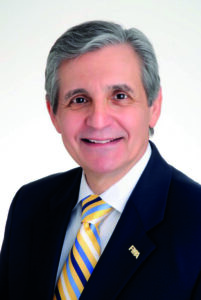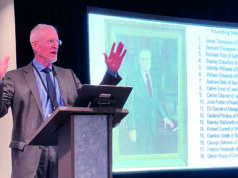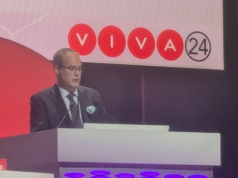
On March 22, 1978, Karl Wallenda went up on a high wire in Puerto Rico strung between two high-rise buildings. There was no safety net. The winds were blowing hard. A crowd was massed below, awaiting the event. As a seasoned circus performer, he knew that a star never disappoints the crowd. Even at the risk of his own death. He was the founder of the world-renowned family circus troupe called The Great Wallendas, famous for performing daredevil acts without a safety net.
In 1962, The Great Wallendas began forming their “human pyramid,” a stunt they had been performing for many years. As they made their way to the wire, the pyramid collapsed. Two family members were killed and one was paralyzed. Karl, the patriarch of the family, managed to catch one performer with his legs, saving his life. Karl ultimately fell, broke his ribs, but miraculously survived. Although he continued to perform, the memory of that tragic day haunted him incessantly.
On that day in 1978, standing ringside at Madison Square Garden, I was watching Tito Gaona, renowned aerialist for the Barnum and Bailey Circus, attempt his quadruple somersault. He was a master in his own right, performing the triple somersault so effortlessly that it became boring. He came out of the rotation easily, but his catcher, his cousin Laio Murillo, could not hold on, and Tito fell to the net. As show time approached, they tried four times and gave up.
Tito and his cousin went to their dressing room to change into their costumes. The ringmaster could be heard in the background starting the show. “Ladies and Gentlemen, and children of all ages…” bellowed in the distance. The show had begun. Tito and his cousin came into the doctor’s office, a few paces from the Madison Square Garden arena, waiting for their event. The office was a hangout for entertainers, security guards, executives and whoever passed by to chew the fat, and often to receive a vitamin B shot, which they thought was universally curative. A cheap black-and-white television, perched on the desk, droned mindless blather. As Tito and his cousin entered, programming was interrupted to announce a tragedy that had just occurred in Puerto Rico: the great Karl Wallenda had fallen to his death.
We stood there in stunned silence. The reporter described the scene and attempted to attribute cause. “Karl should have never been up there in the first place; the wire had not been set properly; the winds were too high; he was too old.” He was a great performer for the ages, he continued.
After several minutes of reflection, Tito broke the silence remarking: “Karl has finally paid for his sin.” It was a statement that seemed incongruous with those offered by the television reporter a few moments earlier. The group standing around the TV performed similar tricks and risked their lives nightly. Clearly their protective confidence had been penetrated by Karl’s death.
Afraid to break reverence of the moment, I mindlessly blurted, “What sin?”
Tito replied, “Karl never dropped his pole. Doing so, he may have killed spectators below. But, had he done that, he could have pulled himself back onto the wire and saved himself. He knew it was time to pay for his sin”: the human pyramid that had killed members of his family, for which he had never forgiven himself.
Self-reproach takes many forms.
Oppenheimer—both the film and the individual—is a complex depiction of existential choices faced by imperfect men at critical junctures in human history. “Oppie,” as he was called by his friends, was a Jewish scientist and an expert in quantum physics, tasked with the responsibility of creating the atom bomb. He was selected because of his intense desire to avenge the death of Jews in the Nazi concentration camps. J. Robert Oppenheimer was offered the responsibility of creating a weapon so powerful it would redefine warfare. It would also instill existential fear. Like Prometheus, who brought both salvation and fiery destruction to humanity, this weapon would bring hope for ending the war in Japan—but bore the potential of causing cataclysmic destruction to end humanity.
“Could this bomb vaporize the atmosphere?” Oppenheimer was asked.
“We don’t know, but almost zero probability,” was his reply. Almost zero? Is that the best we can do?
Back then, as Oppenheimer discovers the purpose of the project is to bomb two Japanese cities and end the war, he becomes increasingly despondent. Aware that the 200,000 Japanese casualties will be comprised of combatants and innocents alike, he vigorously opposes creating the far more lethal hydrogen bomb. Rich in symbolism, he names the site for the first detonation, Trinity.
Oppenheimer has now become the angel of death. Unlike Prometheus, his liver will not be eaten daily by an eagle sent as punishment by Zeus, but his conscience will perpetually search for moral relief. Prometheus’ liver regenerated at night. Oppenheimer woke every day to face the same self-reproach. President Harry S. Truman offered him respite by saying that he didn’t make the decision to drop the bomb and kill those people: “I did! “You only made it!” In that confrontational meeting, an exasperated Truman yelled at his Secretary of War, Henry L. Stimson, to “get that cry-baby out of here!” He was referring to Oppenheimer.
As a means of seeking vindication, he appealed to a committee arranged to decide if Oppenheimer should continue his leadership of the Atomic Energy Commission. The committee was ostensibly centered on national security and support for the even deadlier hydrogen bomb. Its real purpose was to get rid of Oppenheimer, a troubled human who realized what he had released into the world.
Before Oppenheimer’s appearance, he bellowed to his wife, “They [the people] must hear this.” The hostile meeting was a surrogate for his anguish. Members of the committee were selected to prevent his continued leadership since he realized that further development of weapons of mass destruction would only hasten mankind’s demise. Anticipating the committee’s decision, his wife said: “They will never give it to you.” What she meant was: they will grant you neither the chairmanship, nor forgiveness.
Predictably, he was rejected.
How does this apply to vascular surgery? Some years ago, my partner and I performed an open aneurysm repair on a healthy 60-year-old male. The patient worked out every day and was a prominent lawyer in the community. The operation went along flawlessly: the graft was sewn in and the retroperitoneum closed. Heparin was reversed with protamine with no issue. Vital signs were stable. My partner scrubbed out to enter post-op orders. The anesthesiologist asked if I wanted to return the cell-saved blood. Although we had not lost much, I reasoned that it was his blood and would make his recovery that much easier. I agreed and the perfusionist spun down the blood and began the infusion. At that moment, disaster struck.
His blood pressure and saturation fell to zero. We immediately performed a transesophageal echocardiogram. The images were staggering. Both atria and ventricles were filled with clot, as were the pulmonary artery and aorta. The patient had suddenly clotted his vascular system for no apparent reason. We thought of extracorporeal membrane oxygenation (ECMO), but there was literally nothing to be done.
We called around the country seeking information or if anyone had ever experienced a similar complication. A professor at Emory in Atlanta suggested antiphospholipid antibody syndrome or preformed anti-heparin antibodies. Our hospital did an investigation and came up with nothing. We met with the widow multiple times and tried (but failed) to give her an explanation.
Understandably, the wife obtained the best malpractice law firm in the area. When I received the intent-to-sue letter, I did something I had never done before and called the attorney. I told him that I had no idea why that patient clotted his heart, that I had never seen that happen before, and that I hoped to never see it again. I told him of the research that we did and that, if his experts had any insight, to please share it. We never heard from him again.
The renowned Boston vascular surgeon, Alan Callow, used to say that the ghosts of our failures parade around our bed at night. Yet, every patient we place on the operating table is put at risk. It takes a special person to accept this heavy responsibility, and we all carry the emotional burden of our failures. How we seek expiation is a matter of personal accommodation. A resident who worked with Dr. Charles Bailey, a pioneer in pediatric cardiac bypass surgery in the 1950s, told me that Bailey lost his first 74 patients. The resident approached Dr. Bailey, asking: “Dr. Bailey, don’t you think we should stop?” Bailey responded: “No! We are close!” The 75th patient survived.
I’m not sure that many of us would have had the callousness to continue after losing 74 patients, nor would it even be possible today. But we surgeons all face similar responsibilities and bear the weight of our failures. And somehow, we return to the operating room the next day wizened, but humbled. To survive, we either develop emotional callousness, or realize that the good we do for most patients outweighs our failures. Or both.
Before he accepted the leadership of the atom bomb project, Albert Einstein asked Oppie: “Do you think you will be able to handle the consequences?” Oppenheimer did not answer.
As each practitioner seeks their own reconciliation, we acknowledge that our choice is not an easy profession—replete with gratification but often humbling.
Arthur E. Palamara, MD, is a vascular surgeon in Hollywood, Florida.












